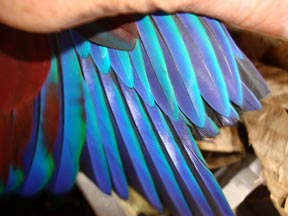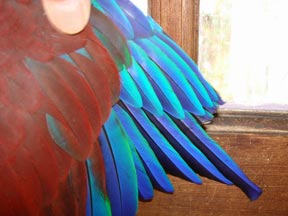|
Always start clipping at the tips of the wings. Over a period of time determine just how many flight feathers a bird needs to fly. It varies from species to species, and even from bird to bird, because different birds have different builds and flight musculature. The usual number of primary feathers to be trimmed so a bird cannot gain altitude, would be the first six feathers as seen in the illustration. The end result should be a bird that can glide safely to the floor. That sort of clipping is NOT a guarantee outdoors, because even a slight breeze can provide the lift needed to get them to the top of a tree. There is no clip that will prevent escapes in the outdoors if a bird's wing clip is not checked and updated frequently. Most escapes occur when a wing clip has grown out without the owner's realization. When we do our own wing clips, we are responsible for making sure that we don't clip blood feathers. They are easily recognizable and can be seen if we know what to look for. Basically, avoid cutting any feather with a soft and swollen blood-filled portion that is bluish-pink in color. To protect a blood feather, some recommend leaving a feather on either side of it for support. Never give a parrot a one-wing clip. Many accidents have been caused by this out-of-date clip that leaves a bird unbalanced. A bird with this clip will almost surely crash into something when they attempt to fly.
This is the plan for trimming primary feathers, showing the actual bird wings spread out for additional clarity. This is easy to do yourself. These are photos of two of my Eclectus boys, with their wings spread out to show where to trim. The photos basically look the same as the drawing. Look for those secondary feathers....they are just below my thumbs and are more turquoise. Use the end tips of those secondaries as a pattern to trim the primaries. The end of the secondary feathers is the length the primaries need to be trimmed to. Be careful to not trim the secondary feather tips when you are cutting. I went to Staples in search of a GOOD pair of scissors. I had been using hair trimming scissors to trim flight feathers, and they chew and mangle rather than cut, when it comes to cutting feathers. I bought a pair of seven inch titanium scissors for about eight dollars, and they are sure slick. Worth every penny. They cut a neat feather edge, like a hot knife through butter! For a subtle "attitude adjustment", only trim two primary feathers on each side to start with. Some birds this will not slow up at all. You may have to trim three to four primary feathers from each side, before the bird will become more "humble". This small number of primary feathers trimmed will still allow a bird to fly, but a light trim like this would not be safe to trust taking a bird outdoors with. |
||
|
©2001 Susie Christian. Photography by Susie Christian©
|






